Papers by Fernando Ordóñez

Restricted until 23 April 2009. Wireless Sensor Networks (WSNs) is an area of active research in ... more Restricted until 23 April 2009. Wireless Sensor Networks (WSNs) is an area of active research in industry and academia. WSNs can be used in a wide array of applications such as, battlefield surveillance, aerospace exploration, environmental monitoring, products tracking and supply chain management, homeland security applications, and so on. In this dissertation, we study algorithms that address two challenges faced by WSNs in applications: the need to operate distributedly and to take into account uncertain conditions. We first work on constructing efficient distributed routing algorithms for maximal data extraction problem, the second part of this thesis focuses on the effect of considering uncertain conditions for routing in WSN. The last part of the thesis introduces methodologies that address uncertainty to achieve secure localization in hostile environments.; We develop efficient distributed routing algorithms for data extraction by using the Lagrangian relaxation method and th...

In this paper we analyze general Stackelberg games (SGs) and Stackelberg security games (SSGs). S... more In this paper we analyze general Stackelberg games (SGs) and Stackelberg security games (SSGs). SGs are hierarchical adversarial games where players select actions or strategies to optimize their payoffs in a sequential manner. SSGs are a type of SGs that arise in security applications, where the strategies of the player that acts first consist in protecting subsets of targets and the strategies of the followers consist in attacking one of the targets. We review existing mixed integer optimization formulations in both the general and the security setting and present new formulations for both settings. We compare the SG formulations and the SSG formulations both from a theoretical and a computational point of view. Our theoretical results show that the new formulations provide tighter linear relaxations. Our computational experiments show that the new formulations give better solution times.
In this work we focus on Stackelberg equilibria for discounted stochastic games. We begin by form... more In this work we focus on Stackelberg equilibria for discounted stochastic games. We begin by formalizing the concept of Stationary Strong Stackelberg Equlibrium (SSSE) policies for such games. We provide classes of games where the SSSE exists, and we prove via counterexamples that SSSE does not exist in the general case. We define suitable dynamic programming operators whose fixed points are referred to as Fixed Point Equilibrium (FPE). We show that the FPE and SSSE coincide for a class of games with Myopic Follower Strategy. We provide numerical examples that shed light on the relationship between SSSE and FPE and the behavior of Value Iteration, Policy Iteration and Mathematical programming formulations for this problem. Finally, we present a security application to illustrate the solution concepts and the efficiency of the algorithms studied in this article.
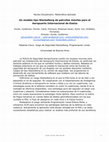
La Policía de Seguridad Aeroportuaria cuenta con escasos recursos para patrullar las instalacione... more La Policía de Seguridad Aeroportuaria cuenta con escasos recursos para patrullar las instalaciones del Aeropuerto Internacional de Ezeiza, en particular los sectores públicos en los que se cometen hurtos y delitos menores. Basados en trabajos anteriores en los que se modela la interacción entre las fuerzas de seguridad del Aeropuerto de Los Ángeles con los posibles atacantes mediante Juegos de tipo Stackelberg en su versión de seguridad, nos proponemos el desarrollo de una herramienta de software que colabore con las labores de prevención de delitos. Definimos un Juego Stackelberg en el que la PSA toma el rol de líder y los atacantes el rol de seguidor. En cooperación con el Departamento de Inteligencia Criminal dividimos el aeropuerto en zonas y éstas a su vez en cuadrículas. Las estrategias puras de la defensa consisten en cubrir N cuadrículas, donde N es la cantidad de efectivos disponibles. Una estrategia pura del seguidor es elegir una cuadrícula y atacarla. Consideramos todos ...
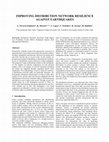
IET International Conference on Resilience of Transmission and Distribution Networks (RTDN 2017), 2017
Historically, reliability analysis has ignored the occurrence of natural hazards such as those as... more Historically, reliability analysis has ignored the occurrence of natural hazards such as those associated with extreme weather, flooding, earthquakes and tsunamis, which are becoming more and more relevant due to recent events. In this context, we present an assessment methodology to determine the resiliency levels of a distribution system exposed to a major earthquake. The proposed 4-stage methodology models (i) the earthquake, (ii) the fragility of network components, (iv) the network outages, and (v) the impacts on network operation (including the energy not supplied) through sequential Monte Carlo simulations. This methodology is used to study the resilience of distribution networks under two particular strategies: one that hardens substations infrastructure in order to reduce their fragility levels, and the other one that uses additional network infrastructure in the form of transfer cables to shift load among substations in case a major event occurs. Through several case studies based on a real distribution network in Chile, we demonstrate that hardening substations infrastructure may be a more resilient way to deal with earthquakes, even when compared to an alternative, extreme case where a vast number of transfer cables are installed to support damaged substations.

Lecture Notes in Computer Science, 2017
We present a decision support system to help plan preventive border patrols. The system represent... more We present a decision support system to help plan preventive border patrols. The system represents the interaction between defenders and intruders as a Stackelberg security game (SSG) where the defender pools local resources to conduct joint preventive border patrols. We introduce a new SSG that constructs defender strategies that pair adjacent precincts to pool resources that are used to patrol a location within one of the two precincts. We introduce an efficient formulation of this problem and an efficient sampling method to construct an implementable defender strategy. The system automatically constructs the Stackelberg game from geographically located past crime data, topology and cross border information. We use clustering of past crime data and logit probability distribution to assign risk to patrol areas. Our results on a simplified realworld inspired border patrol instance show the computational efficiency of the model proposed, its robustness with respect to parameters used in automatically constructing the instance, and the quality of the sampled solution obtained.
16th International Conference on Soft Computing Models in Industrial and Environmental Applications (SOCO 2021), 2021

Thesis (Ph. D.)--Massachusetts Institute of Technology, Sloan School of Management, 2002. Include... more Thesis (Ph. D.)--Massachusetts Institute of Technology, Sloan School of Management, 2002. Includes bibliographical references (p. 213-216). The modern theory of condition numbers for convex optimization problems was developed for convex problems in conic format: ... The condition number C(d) for (CPd) has been shown in theory to provide upper and/or lower bounds on many behavioral and computational characteristics of (CPd), from sizes of feasible and optimal solutions to the complexity of algorithms for solving (CPd). However, it is not known to what extent these bounds might be reasonably close to their actual measures of interest. One difficulty in testing the practical relevance of such theoretical bounds is that most practical problems are not presented in conic format. While it is usually easy to transform convex optimization problems into conic format, such transformations are not unique and do not maintain the original data, making this strategy somewhat irrelevant for comput...
GPS data of vehicles travelling on road networks can be used to estimate travel times. This requi... more GPS data of vehicles travelling on road networks can be used to estimate travel times. This requires the identification of the corresponding paths in the network. We developed algorithms identifying a path minimizing a special distance with a GPS trajectory even in presence of cycles. Mild assumptions over the GPS precision and the use of heuristic steps allow fast map matchings. We compared these algorithms over 30000 real and generated GPS samples on a grid graph and two real life networks. We show that on average, our algorithm and the heuristic return in minutes paths that have respectively 92.5% and 89% of the trajectory in a corridor of one meter around them.
Optimization Letters, 2012
Your article is protected by copyright and all rights are held exclusively by Springer-Verlag. Th... more Your article is protected by copyright and all rights are held exclusively by Springer-Verlag. This e-offprint is for personal use only and shall not be self-archived in electronic repositories. If you wish to self-archive your work, please use the accepted author's version for posting to your own website or your institution's repository. You may further deposit the accepted author's version on a funder's repository at a funder's request, provided it is not made publicly available until 12 months after publication.

Mathematical Programming, 2006
We study four measures of problem instance behavior that might account for the observed differenc... more We study four measures of problem instance behavior that might account for the observed differences in interior-point method (IPM) iterations when these methods are used to solve semidefinite programming (SDP) problem instances: (i) an aggregate geometry measure related to the primal and dual feasible regions (aspect ratios) and norms of the optimal solutions, (ii) the (Renegar-) condition measure C(d) of the data instance, (iii) a measure of the near-absence of strict complementarity of the optimal solution, and (iv) the level of degeneracy of the optimal solution. We compute these measures for the SDPLIB suite problem instances and measure the correlation between these measures and IPM iteration counts (solved using the software SDPT3) when the measures have finite values. Our conclusions are roughly as follows: the aggregate geometry measure is highly correlated with IPM iterations (CORR = 0.896), and is a very good predictor of IPM iterations, particularly for problem instances with solutions of small norm and aspect ratio. The condition measure C(d) is also correlated with IPM iterations, but less so than the aggregate geometry measure (CORR = 0.630). The near-absence of strict complementarity is weakly correlated with IPM iterations (CORR = 0.423). The level of degeneracy of the optimal solution is essentially uncorrelated with IPM iterations.

Journal of the Operational Research Society, 2007
In many applications, the network design problem (NDP) faces significant uncertainty in transport... more In many applications, the network design problem (NDP) faces significant uncertainty in transportation costs and demand, as it can be difficult to estimate current (and future values) of these quantities. In this paper, we present a robust optimization-based formulation for the NDP under transportation cost and demand uncertainty. We show that solving an approximation to this robust formulation of the NDP can be done efficiently for a network with single origin and destination per commodity and general uncertainty in transportation costs and demand that are independent of each other. For a network with path constraints, we propose an efficient column generation procedure to solve the linear programming relaxation. We also present computational results that show that the approximate robust solution found provides significant savings in the worst case while incurring only minor sub-optimality for specific instances of the uncertainty.
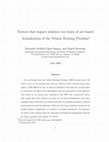
It is well known that the Vehicle Routing Problem (VRP) becomes more difficult to solve as the pr... more It is well known that the Vehicle Routing Problem (VRP) becomes more difficult to solve as the problem size increases. However little is known about what makes a VRP difficult or easy to solve for problems of the same size. In this paper we investigate the effect of the formulation and data parameters on the efficiency with which we can obtain exact solutions to the VRP with a general IP solver. Our results show that solution run times for arc-based formulations with exponentially many constraints are mostly insensitive to problem parameters, whereas polynomial arc-based formulations, which can solve larger problems because of the smaller memory requirement, are sensitive to problem parameters. For instance, we observe that solution times for polynomial formulations significantly decrease for larger capacities and number of vehicles. ∗Research supported by NSF under grant CMS-0409887 †Corresponding author
Recent technological developments such as GPS, mobile devices and increases in data storage and c... more Recent technological developments such as GPS, mobile devices and increases in data storage and computation capacity have greatly enhanced the communication capabilities of travelers, facilitating ridesharing in real-time. This opportunity has created a new ridesharing industry built on making use of the unused vehicle capacity moving about on the roads. There are however still important barriers for widespread dynamic ridesharing adoption. It therefore becomes important to better understand the problems and challenges of ridesharing, creating the need for novel research that explicitly takes into account dynamic ridesharing. In this tutorial we review recent research on new vehicle routing models, cost sharing mechanisms, and planning models that incorporate ridesharing.

Transportation Research Part B: Methodological, 2015
It is estimated that 76% of commuters are driving to work alone while each of them experiences a ... more It is estimated that 76% of commuters are driving to work alone while each of them experiences a 38-hour delay annually due to traffic congestion. Ridesharing is an efficient way to utilize the unused capacity and help with congestion reduction, and it has recently become more and more popular due to new communication technologies. Understanding the complex relations between ridesharing and traffic congestion is a critical step in the evaluation of a ridesharing enterprise or of the effectiveness of regulatory policies or incentives to promote ridesharing. The objective of this paper is to introduce a mathematical framework for the study of the ridesharing impacts on traffic congestion and to pave the way for the analysis of how people can be motivated to participate in ridesharing, and conversely, how congestion influences ridesharing activities. We accomplish this objective by developing a new traffic equilibrium model with ridesharing, and formulating the model as a mixed complementarity problem (MiCP). We provide conditions on the model parameters under which there exists one and only one solution to this model. The computational results show that when the congestion cost decreases or the ridesharing inconvenience cost increases, more travelers would become solo drivers and thus less people would participate in ridesharing. On the other hand, when the ridesharing price increases, more travelers would become ridesharing drivers.
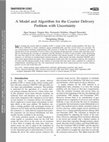
Transportation Science, 2010
W e consider the courier delivery problem (CDP), a variant of the vehicle routing problem with ti... more W e consider the courier delivery problem (CDP), a variant of the vehicle routing problem with time windows (VRPTW) in which customers appear probabilistically and their service times are uncertain. We use scenario-based stochastic programming with recourse to model the uncertainty in customers and robust optimization for the uncertainty in service times. Our proposed model generates a master plan and daily schedules by maximizing the coverage of customers and the similarity of routes in each scenario, while minimizing the total time spent by the couriers and the total earliness and lateness penalty. To solve large-scale problem instances, we develop an insertion-based solution heuristic, called master and daily scheduler (MADS), and a tabu search improvement procedure. The computational results show that our heuristic improves the similarity of routes and the lateness penalty at the expense of increased total time spent when compared to a solution of independently scheduling each day. Our experimental results also show improvements over current industry practice on two real-world data sets.

Journal of the Operational Research Society, 2010
The federal government maintains large quantities of medical supplies in stock as part of its Str... more The federal government maintains large quantities of medical supplies in stock as part of its Strategic National Stockpile (SNS) to protect the American public in case of a public health emergency. Managing these large perishable inventories effectively can help reduce the cost of the SNS and improves national security. In this work, we propose a modified Economic Manufacturing Quantity (EMQ) model for perishable inventory with a minimum volume constraint. We identify when this model is necessary and show that minimizing the cost of maintaining such a system can be formulated as a non-convex non-smooth unconstrained optimization problem. We present an efficient exact algorithm to solve this problem. We illustrate the model and algorithm with numerical results for an example managing stocks of Cipro, an antibiotic to treat people for anthrax infection. We demonstrate the advantage of our proposed model over a standard model and perform sensitivity analysis on the government-controlled system parameters. We show that the government can obtain lower costs or a larger stockpile at the same cost by allowing more freedom in the management of the stocks.
Computers & Industrial Engineering, 2013
This article appeared in a journal published by Elsevier. The attached copy is furnished to the a... more This article appeared in a journal published by Elsevier. The attached copy is furnished to the author for internal non-commercial research and education use, including for instruction at the authors institution and sharing with colleagues. Other uses, including reproduction and distribution, or selling or licensing copies, or posting to personal, institutional or third party websites are prohibited. In most cases authors are permitted to post their version of the article (e.g. in Word or Tex form) to their personal website or institutional repository. Authors requiring further information regarding Elsevier's archiving and manuscript policies are encouraged to visit: http://www.elsevier.com/authorsrights
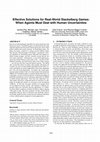
Algorithms, Deployed Systems, Lessons Learned
How do we build multiagent algorithms for agent interactions with human adversaries? Stackelberg ... more How do we build multiagent algorithms for agent interactions with human adversaries? Stackelberg games are natural models for many important applications that involve human interaction, such as oligopolistic markets and security domains. In Stackelberg games, one player, the leader, commits to a strategy and the follower makes their decision with knowledge of the leader's commitment. Existing algorithms for Stackelberg games efficiently find optimal solutions (leader strategy), but they critically assume that the follower plays optimally. Unfortunately, in real-world applications, agents face human followers (adversaries) who-because of their bounded rationality and limited observation of the leader strategy-may deviate from their expected optimal response. Not taking into account these likely deviations when dealing with human adversaries can cause an unacceptable degradation in the leader's reward, particularly in security applications where these algorithms have seen real-world deployment. To address this crucial problem, this paper introduces three new mixed-integer linear programs (MILPs) for Stackelberg games to consider human adversaries, incorporating: (i) novel anchoring theories on human perception of probability distributions and (ii) robustness approaches for MILPs to address human imprecision. Since these new approaches consider human adversaries, traditional proofs of correctness or optimality are insufficient; instead, it is necessary to rely on empirical validation. To that end, this paper considers two settings based on real deployed security systems, and compares 6 different approaches (three new with three previous approaches), in 4 different observability conditions, involving 98 human subjects playing 1360 games in total. The final conclusion was that a model which incorporates both the ideas of robustness and anchoring achieves statistically significant better rewards and also maintains equivalent or faster solution speeds compared to existing approaches.









Uploads
Papers by Fernando Ordóñez